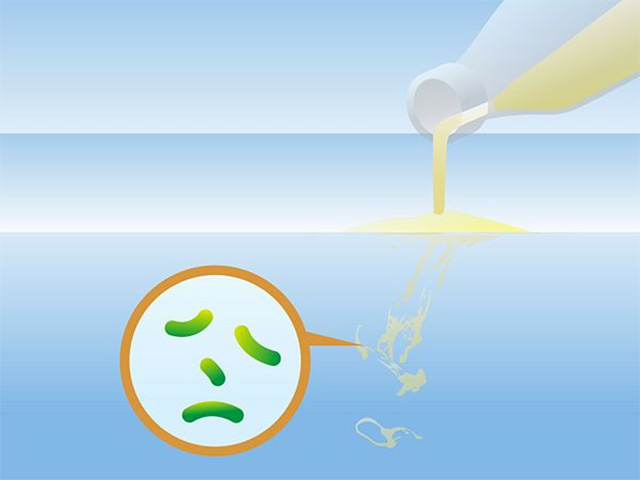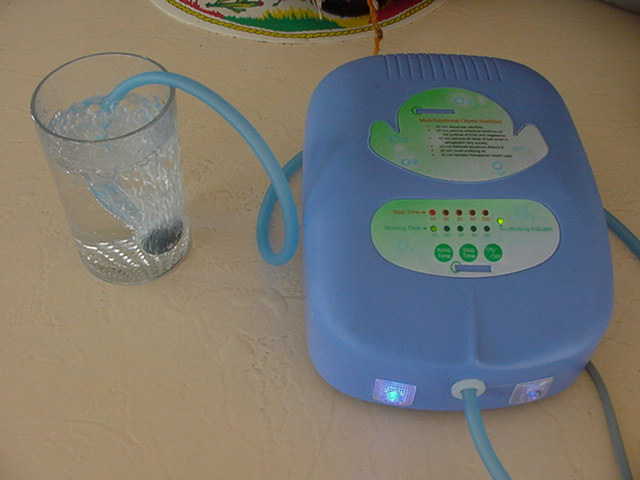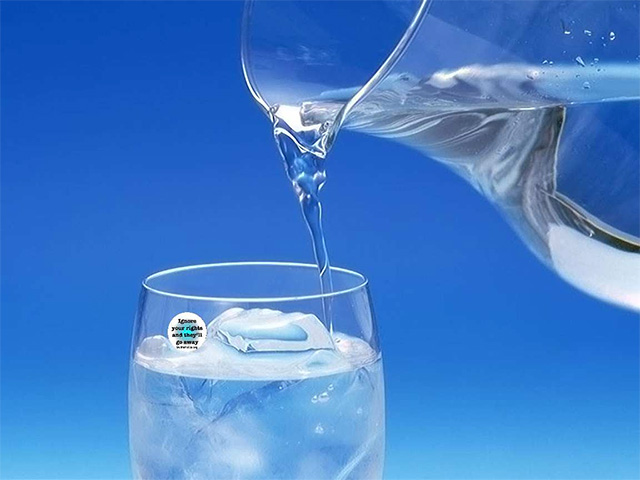Pure water It is a guarantee of human health and the environment around it. Unfortunately, our ecology suffers from many factors that affect its pollution. These can be industrial emissions, exhaust gases, sewage drains, and so on. They have a negative impact on water quality.
The deterioration of the environmental situation directly affects the state of drinking water
Factors causing water pollution
Water tends to get polluted. This is due to various external factors. Animals or birds can accidentally fall into the well, which, as a result of death, begin to decompose. Household garbage is a source of bacteria in the water.Spring floods can flood the well, filling it with dirt and waste. Household and industrial effluents, without good treatment, getting into groundwater, degrade their quality. Also unfavorable factors include the use of various fertilizers and chemicals on agricultural land.
Signs of poor quality well water are a change in its color, the appearance of an unpleasant odor and taste. Therefore, to maintain its purity and preserve all useful properties, it is necessary to periodically clean the well.
Water can be degraded by the following:- Storm water;
- Industrial drains;
- Wastewater from human household activities;
- Organic and inorganic substances that come from the soil and are involved in the recycling process.

The water needs to be cleaned periodically even because of the time. The walls of structures can become silted, and dust and dirt can spoil the taste of the liquid. It is also important to conduct a biochemical analysis of water used for drinking and cooking, for compliance with its required standards.
Water disinfection methods
Periodic cleaning of the bottom and walls of wells serve to prevent the deterioration of the quality of drinking water. It is also necessary to carry out scheduled inspections of water supply and sewerage systems. The well must be covered with a lid to prevent the ingress of foreign objects.
Water purification methods can be carried out using:- Strong oxidizing agents (ozone, chlorine dioxide, iodine, chlorine, potassium permanganate, sodium hypochlorite);
- Germicidal rays, ultrasound;
- Boiling (thermal method);
- Sorption (use of active carbon);
- Oligodynamia (using silver ions);
The most common methods are chlorination and ozonation. The choice of disinfection method also depends on the volume of water to be disinfected and the degree of its contamination.
Chlorination method
This method includes the use of chlorine, bleach and their derivatives. Chlorination is also used in water treatment plants. Under the influence of chlorine, the bacteria in the liquid die. The method of chlorinating wells is described.
For high-quality cleaning, water must be well mixed with chlorine and kept in contact with it for half an hour or more. Only then can it be served to the consumer.
The required consumption of chemicals is determined by specialists using process analysis. The content of residual chlorine (reacted) in one liter of water supplied to the consumer should be 0.3-0.5 mg. This indicator is a condition of sanitary reliability. When chlorinating water, the dose of chlorine is 1-2 mg per liter of liquid, depending on its chlorine absorption. For groundwater, this figure is 0.7 mg per liter.
Disinfection of wells is carried out using chemical solutions and preparations. Safe chlorine compounds have proven themselves best. Before disinfection of water, the walls of the well are first treated. To do this, use a solution prepared at the rate of 20 g of bleach per 1 liter of water.
Bleach can be replaced with household chemicals, such as "Whiteness". Then you need 50 mg of funds per 1 liter of water. This composition is applied to the walls of the well using a sprayer, brush or roller. In this case, you need to use a respirator to protect the respiratory tract from exposure to chlorine. Surface coverage with disinfectant solution must be uniform.
To prepare a disinfectant solution, chlorine must be dissolved only in cold water. Under the influence of temperature, it evaporates, as a result of which the disinfectant properties of the composition will be lost.
Then the chlorine solution is poured directly into the well, thoroughly mixed, covered with a lid and left for a day. Do not drink treated water. After 24 hours, it is pumped out. The walls of the well are thoroughly washed with fresh water, pouring and pumping it out several times. You can use a pump for this purpose.
After about a week, the residual smell of chlorine will disappear, and the water will please with its safety and cleanliness. You can read more about cleaning wells on this page /chistka_kolodcev.html.
Specialized field teams will help to comply with all water purification technology. They have all the necessary equipment and chemicals for fast and high-quality disinfection of water. Also, with the help of special reagents, you can check the quality of purified water and how it meets hygienic standards.

Water ozonation - water purification with ozone - much more effective than chlorine
Ozonation method
The technology of purifying drinking water using ozone is called ozonation. Proven to be better than chlorination. This is a very popular method of water disinfection, as harmful bacteria quickly die when exposed to ozone. It is a strong disinfectant. The property of the gas is not lost even when it is dissolved in water.
Ozone dissolves well in water and is effective against bacteria and mold. One of the advantages of the ozonation method is the absence of toxic substances in the treated water, in comparison with chlorination.
When scientists conducted experiments, it turned out that the polio virus dies from a two-minute exposure to 0.5 mg of ozone dissolved in 1 liter of water. With an increase in the concentration of the solution, all other types of bacteria are destroyed within one minute.
Ozone has the ability to decolorize water 15-30 times faster than chlorine. To disinfect the same volume of water, you will need several times less ozone than chlorine. Gas gives the water a pronounced blue tint, and chlorine colors the water yellow-green. Ozone also eliminates all foreign odors and tastes of river water. The ozonation method is mainly used to purify large volumes of water.
germicidal ray method
- Coli index (titer of Escherichia coli) of the source water is less than 1 thousand units per liter;
- Turbidity less than 2 mg per liter;
- The iron content is less than 0.3 mg/l.
This purification method has several advantages over chlorination. Radiation does not change the chemical properties of water and its taste. After treatment, the water can be consumed immediately
Disinfection using bactericidal treatment is much faster than other methods. The liquid is immediately ready for supply to consumers. The operation of such treatment plants is easier than a system using chlorine. Radiation destroys most types of harmful microorganisms.
Ultraviolet rays have the greatest bactericidal effect. Their wavelength is from 200 to 295 microns. This interval is bactericidal. At a wavelength of 260 micrometers, you can get the maximum effect from disinfection.
Bactericidal treatment is effective for groundwater or previously treated water. In the case of untreated turbid water or with a high iron content, the absorption coefficient will be high, which makes this treatment method inefficient and also not economically viable.
Water in different natural sources has a different light absorption coefficient, which must be determined experimentally. Depending on the indicator, you can choose a rational way to disinfect the liquid
To ensure that drinking water meets all sanitary standards, it is necessary to make sure that it is of high quality by taking appropriate samples. Such biochemical analyzes can be performed by special laboratories. Therefore, it is worth entrusting the problem of water disinfection to specialists who have extensive experience in this field of activity and possess all the necessary reagents.
Drinking water quality standards
Drinking water must meet sanitary quality standards. The health of the population and the epidemiological situation in general will depend on this. When drinking bad water, there is a risk of contracting infectious diseases.
Water must meet the following requirements:- Harmlessness and safety in chemical composition;
- Favorable organoleptic indicators;
- Absence of radionuclides.
GOSTs also standardize the indicator of the residual content of chlorine or ozone, depending on the type of treatment used. Indicators of the mineral composition of water and its radiation safety are taken into account.
The organoleptic indicators of drinking water include its characteristics that a person can feel and evaluate. The assessment is made according to the intensity of these properties and their manifestation "
The main physical and organoleptic indicators:- Smell;
- Turbidity;
- Chromaticity;
- Taste and taste.

The smell of water is determined by the content of impurities or chemicals in it. By their nature, they can be of natural origin or the result of human activity (technogenic). These substances can evaporate and act on the olfactory receptors, which causes certain sensations.
Smells can vary in intensity and character. They can be natural and specific. With an increase in the temperature of the liquid, the sharpness of odors increases, as the volatility of substances dissolved in the liquid increases.
Quality water is considered to be water that does not smell of anything. According to the requirements of the standards, the intensity of the odor of drinking water must be less than 2 points on a 5-point rating scale. The test must be carried out at a liquid temperature of plus 20 degrees, as well as its heating to 60 degrees Celsius
Turbidity is a certain concentration of suspended solids in a certain volume of liquid. Natural haze is caused by the presence of clay, plankton, silt and other inorganic and organic matter. Good water should be transparent, that is, capable of transmitting light rays.
The color of drinking water should be less than 20 degrees. It depends on the presence of humic organic substances that appeared in the process of decomposition of animal and plant residues.
The taste of water is due to the fact that the impurities contained in it irritate certain receptors of the tongue and a person feels the taste. The taste can be bitter, salty, sweet or sour. Everything else will be considered flavor. A five-point system is also used to evaluate these parameters. High-quality drinking water should not have an aftertaste and taste and is estimated at a figure of up to 2 points.
Unpleasant tastes and odors limit the use of the liquid and make it unfit for consumption due to its contamination. High-quality water purification and its disinfection is the key to good health and the absence of negative effects on a person.
Three Wells offers a wide range of services for the construction, repair and disinfection of wells. Experienced specialists are ready to come to you all year round both for a scheduled inspection of the well, and in the event of an unforeseen accident.
Advantages of our company:- Many years of experience in this field;
- Departure of the brigade to the customer at any time convenient for him;
- Contract work;
- Providing a guarantee for services for 1 year;
- Completion of all works within strictly stipulated terms;
- Payment for the services provided is carried out upon completion of work and in case of a successful result;
- Availability of the necessary professional equipment to perform well service.
Contacting the Three Wells company is a guarantee that your water will meet all hygiene standards and water quality indicators. You can get a preliminary consultation and order a service by calling the numbers indicated on the website. We are always happy to help you in the struggle for the use of high-quality drinking water.
